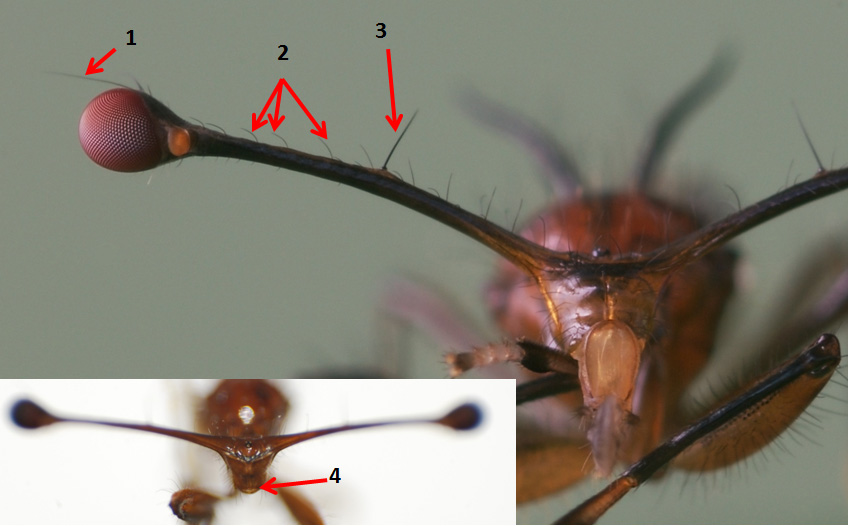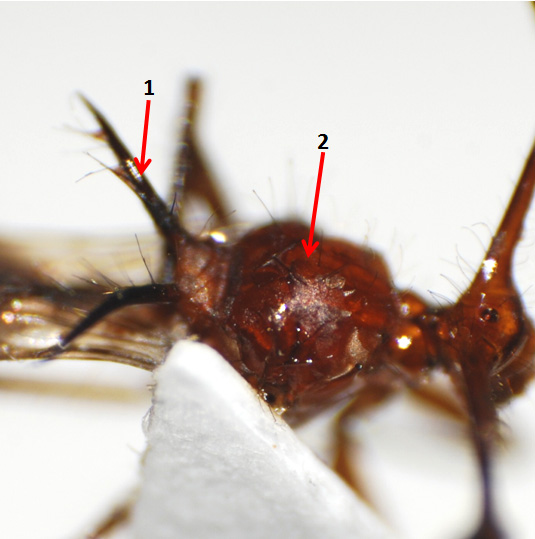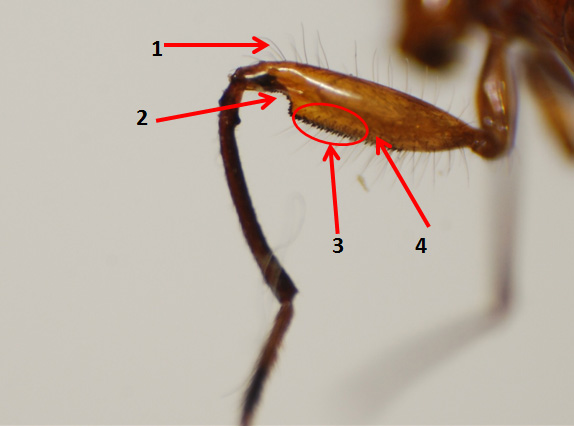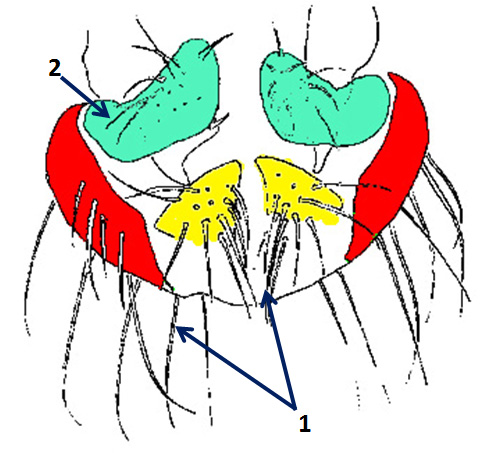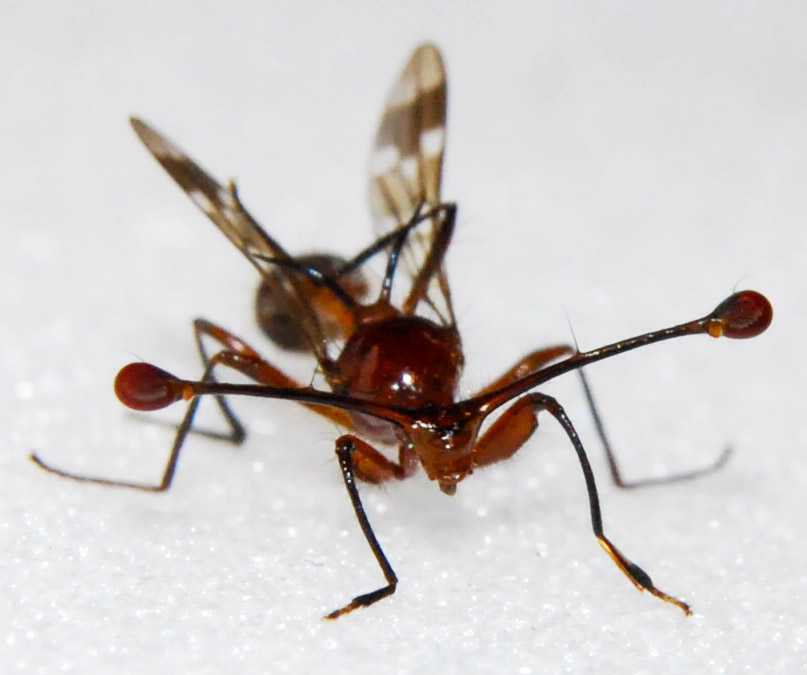 |
| Courtesy of Łukasz Mielczarek |
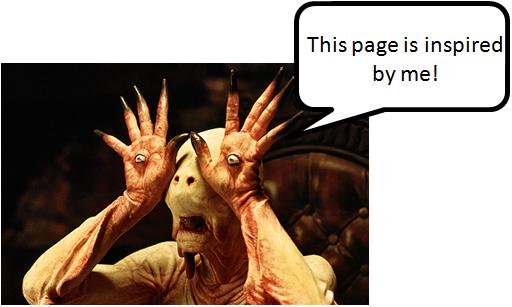 Overview
OverviewWith eyes at the tip of their eye stalk, Teleopsis dalmanni and members of Diopsinae definitely make into the list of most bizarre-looking animals on earth. This group of flies has sparks research interest in the physiology, development and evolutionary mechanism leading to the eye stalks. T. dalmanni is probably the most widely studied particularly in the field of sexual selection leading to sexual dimorphism in this species, where males and females differ in appearance.
The Eye Stalk | Sexual dimorphism and sexual selection in Teleopsis dalmanni | Mating system | Morphology | Taxonomy | Phylogeny | Distribution | Biology | Culturing Teleopsis dalmanni | High mating frequency in Teleopsis dalmanni: Why? | Intrasexual competition in Teleopsis dalmanni | Diopsinae | References
The Eye Stalk
The most striking feature of Teleopsis dalmanni and other members of Diopsinae is definitely the lateral head projection (the “eye stalk”), which bore the eyes and the antenna. The eye stalk is derived from the posterior half of the eye-antennal disc[1] (Figure 1). Visual fields of the compound eyes of Teleopsis dalmanni overlap 3-4 mm in front of their eyes, making it possible for them to perceived depth of objects placed within the overlapping region[2] .
 |
| Figure 1: Mapping of compound eyes (red), antenna (green) and eye-antenna dics (blue) in the stalk-eyed flies (Diopsidae), showing a gradual evolution of eye-stalks from condition 'a' through 'b' and 'c' to 'd': (a) Centrioncus prodiopsis Speiser; (b) Sphyracephala beccari; (c) Sphyracephala (Pseudodiopsis) detrahens Walker; (d) Diopsis thoracica Westwood. (Extracted and modified from Meier & Baker, 2002) |
It should be noted that Stalk-eyed flies are not the only group of Dipteran flies that posses eye stalks (Figure 2; click here for examples of Dipteran with eye stalk). However, they are unique by having the antenna near the end of the eyes stalk, next to the eye instead of in the facial region (Figure 3).
.
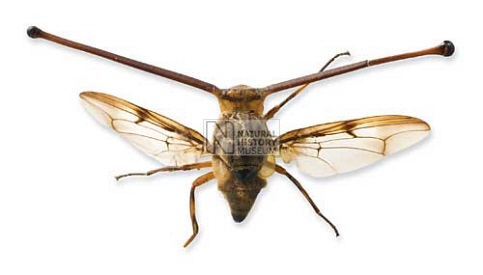 |
| Figure 2: Achias rothschildi, a Signal flies with stalked eye. [Image courtesy of Natural History Museum] |
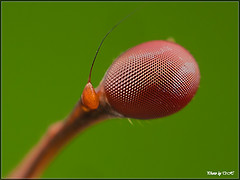 |
| Figure 3: Eyes of a Stalk-eyed flies, showing the position of antenna beside the compund eye. [Image courtesy of TrongHieuSG , used with permission.] |
Sexual dimorphism and sexual selection in Teleopsis dalmanni
Teopsis dalmanni display high degree of sexual dimorphism (Figure 4) . The eye span of males is longer than its body length while in females, it is shorter [3] .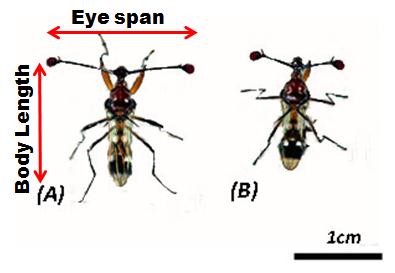 |
| Figure 4: Sexual dimorphism in eye span between male (A) and female (B) Teleopsis dalmanni. [Edited from image courtesy of Dr. Mihály Földvári] |
Female mate choice: Why does females prefer males with longer eye span?
Figure 5: Female Teleopsis dalmanni [Courtesy of Rob Knell, used with permission]
Females Teleopsis dalmanni (Figure 5) were likely to be attracted to sites controlled by male with larger eye span [6] , and there is a genetic basis for females to prefer males with longer eye stalk[7] , thereby creating a selection force for longer eye stalks in males.
Under the handicap hypothesis of mate choice, female judge the quality of males through sexual ornamentation, such as the eye stalk, which are costly to develop. A high-quality male will be able to support longer eye stalks which are costly despite poor condition[8] . It was found that males with larger eye span have bigger accessory glands, testes, and hence are able to mate more frequently than males with smaller eye span[9] . This is beneficial for females as more frequent mating increase the number of sperm received, alleviating the problem of sperm shortage faced by females Teleopsis dalmanni.
(Click here for more information on sperm shortage in females).
However, a study demonstrates that females Teleopsis dalmanni actually laid less fertile eggs after mating with males with larger eye span, indicating that sperms from males with larger eye span have superior competitive ability but not superior fertilization ability compared to their smaller counterparts[10] . Despite this, females still gain direct benefit from mating with larger eye span males by having more sperm transfer per copulation.
Limitation for length of eye span: Why don't males have longer eye stalks?
Since males with longer eye span gain benefits of having more mating opportunities, there is a strong sexual selection force for increasing longer eye stalks in males. However, there is a limit in the length of the eye stalks.The process of developing longer eye stalk could create developmental problems in the larvae stage, leading to high larvae mortality rate in the pupae stage. Longer eye stalk also requires longer development time, which increase the exposure to toxic metabolites produced by conspecific larva, as well as to predators and parasites. Therefore, the length of male eye stalk is maintain by natural selection opposing the force of sexual selection.[11]
Adaptation following longer eye stalk in males
With longer eyestalk, males Teleopsis dalmanni experiences more drag force and moment of inertia during flight. Hence, other traits have coevolved with the longer eyestalk in males. To enhance their flight performance and survival ability, males have larger wings than females[12] . Males also generate stronger moments per wing beat, which probably improve the turning performance during flight to compensate for the higher moment of inertia[13] . Moreover, it was also found that despite the larger moment of inertia of the head, males Teleopsis dalmanni could match the head saccade of females, suggesting that the longer eye stalk is support by an adaptation of the neck apparatus to rotate the wider head [14] .
Male mate choice: Do males choose their mates too?
Study shows that males Teleopsis dalmanni do not choose their mate on their mating status (virgin or mated). However, they produced larger spermatophore when mated to large-eyespan females, suggesting that males might strategically allocate more ejaculation to females with larger eye span. This is because female eye span is found to be an accurate predictor of fecundity. Female with larger eye span can produce more eggs than smaller females and after a single mating, females with larger eye span laid more fertile eggs after than smaller eye span females.[15]
Mating system
Figure 6: A pair of copulating Teleopsis dalmanni. Note that the front legs of the male. are resting on the scutellum spines of the female.[Image embedded from Flickr, permission pending from Dr. Samuel Cotton]
The mating system of Teleopsis dalmanni is characterized by:[16] [17]
1. Short copulation duration: Copulation usually lasted less than a minute
2. Frequent mating in both sexes: In the laboratory, males are capable of mating up to 10 times per hour; while females are capable of mating six times per hour up to 40 times per day!
(Click here to learn why they mate so frequently!)
Between dusk and dawn, Teleopsis dalmanni individuals form nocturnal aggregation on exposed root hairs.The number of females in each aggregation varies[9], while there is normally only a single male or occasionally, two males. This is because during the process of aggregation, males will engage in aggressive competition to displace each other to become owner of the site. Owner of aggregation sites will be rewarded with mating with multiple females in the aggregation. Sometimes, lone males would sneak mate with females in other males’ harem.Watch two T.dalmanni fight in the video (Embed from Flickr, pending permission from Dr. Samuel Cotton) below:
(Click here to see what determines the outcomes of an aggressive interaction!)
Interestingly, field studies in Malaysia reveals that most dimorphic species of Stalk-eyed flies, and none of the monomorphic species, where males and females look alike, form this nocturnal aggregation form this aggregation[18] . This suggest that the behavior of aggregating and intrasexual competition between males, besides sexual selection, is a selection force for sexual dimorphsim in the Stalk-eyed flies.
Morphology
Adult morphologyIn general, adult T.dalmanni are reddish-brown in color, with head, thorax and legs covered with dense hair. They posses eye stalks, and the thorax has long scutellum spines (Figure 7).
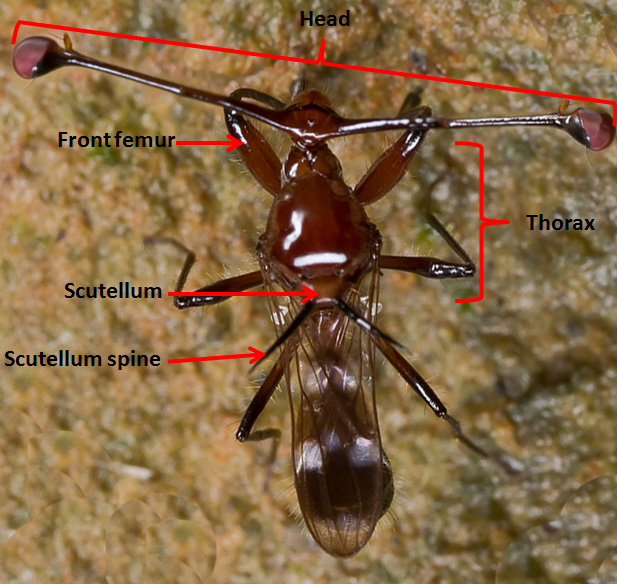 |
| Figure 7: General body plan of Teleopsis dalmanni. [Edited from image courtesy of Kurt aka orionmystery orionmystery.blogspot.com] |
| Head |
1. Outer vertical bristle black twice as long as width of eye-stalk in the middle. 2. Covered with brown hairs. 3. Inner vertical bristle up to 4.5–5 times as long as width of eye-stalk in the middle; on a small tubercle. 4. No facial teeth, edge rounded.
|
||
| Thorax |
1. Scutellar spines up to 4 times as long as length of scutellum. 2. Shiny, reddish-brown, without extensive pollinosity.
|
||
| Legs: Femur |
1. Covered with hairs (shorter than those on the head). 2. With incision near. 3. With rows of peg-like black tubercles in front. 4. Mid femur distally swollen.
|
||
| Male Genitalia |
1. Long setae (bristles) on the epandrium(in red) and the cerci (in yellow). 2. Broad surstyli (in blue).
|
The wing morphology of this species is not describe here as specimens collected from different locality showed considerable variance (Refer here). For a more detailed adult morphology, please refer to here.
Egg morphology
Studies on the egg morphology of Stalk-eyed flies using Scanning Electron Microscope (SEM) demonstrated that egg morphology is useful for identification purposes and for cladistic analysis.[20]
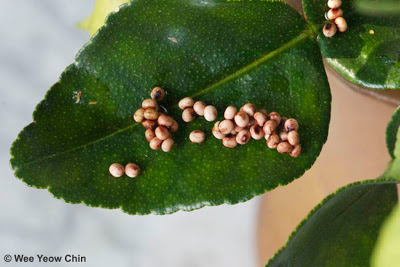 |
| Figure 12: Dorsal view of the egg of Teleopsis dalmanni. [Image edited from Figure 26; Meier& Hilger, 1999] |
 |
| Figure 13: Dichotomous key to delimit four species of Teleopsis. Note that Cyrtodiopsis is renamed as Teleopsisis. [Extracted from Shillito, 1940] |
Taxonomy
Type informationA holotype (Type specimen) is the specimen in which the description of a species is based on. Holotypes for resolving taxonomic confusion, i.e when a 'species' is described under different name (synonyms); or when different species are described as the same species.
Holotype location of Teleopsis dalmanni: Museum of Westermann[22]
Type locality: Jakarta, Indonesia
Taxonomic history
There are 270 species of Stalk-eyed flies, grouped in 14 genus recorded.Teleopsis dalmanni was first described as Diopsis dalmanni by Wiedemann (1830) in Aussereuropäische Zweiflügelige Insekten (Volume t. 2), and was later renamed as Cyrtodiopsis dalmanni, classified under Cyrtodiopsis Frey, 1928. Results from cladistic analysis using both morphological and DNA characteristic later merged Teleopsis and Cyrtodiopsis together and due to naming priority, all Cyrtodiopsis species is renamed to Teleopsis[23] . Hence, what was known as Cyrtodiopsis dalmanni is now Teleopsis dalmanni.
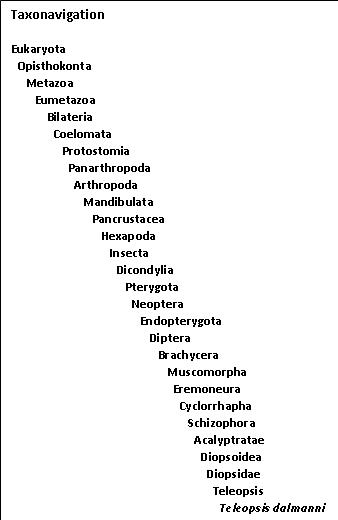 Synonyms
SynonymsDiopsis dalmanni Wiedemann, 1830
Diopsis attenuata Doleschall, 1856
Diopsis lativola Rondani, 1875
Diopsis latimana Rondani, 1875
Teleopsis truncata Brunetti, 1928
Cyrtodiopsis dalmanni (Wiedmann), Frey 1928
Valid name: Teleopsis dalmanni (Wiedmann, 1830)
The list of synonyms probably resulted from the morphologically highly variable Teleopsis dalmanni. There appear to be variation in wing pattern (Figure 14) from specimen collected from different locality (Study of Diopsidae)
[21]. Variation in wing pattern could be a result of poor preservation of specimen, or could be corresponding to variation in habitat.
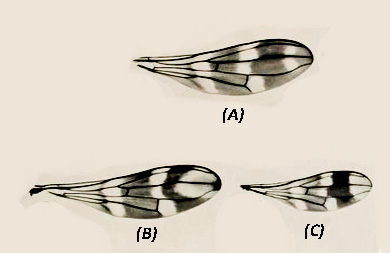 |
| Figure 14: Wing pattern variation of Teleopsis dalmanni collected from Jawa (A,B) and Sarawak (C). Apical band of (A) and (B) differ in thickness, while it is absent in (C). [Edited from Plate I, Studies of Diopsidae] |
Phylogeny
Phylogenetic analysis using both morphology and molecular data revealed that Teleopsis dalmanni are sister species to Teleopsis whitei (Figure 15),which also display sexual dimorphism. The distribution of both species overlap each other (sympatric species), but are reproductively isolated[3]. The two species can be distinguish base on the foreleg morphology as described in the morphology session: Teleopsis whitei do not have the incision in the femora of the front leg. |
| Figure 15: Simplified phylogentic tree showing relationship of Teleopsis dalmanni and several Teleopsis species. [Edited from Figure 2; Meier & Baker, 2002] |
Distribution
SingaporeTill date, there is no proper studies in surveying the diversity of Stalk-eyed flies in Singapore, but they have been photographed by photography enthusiasts in MatRitchie Reservoir Park, Dairy Farm (Figure 16), Singapore Botanic Garden, Bukit Timah and Nee Soon Swamp Forest (MAP). Teleopsis dalmanni could be found in Central Catchement area. Stalk-eyed flies are generally found at shady areas, near edge of forest streams, or in wet muddy area with rotten vegetation in proximate (Figure 17).
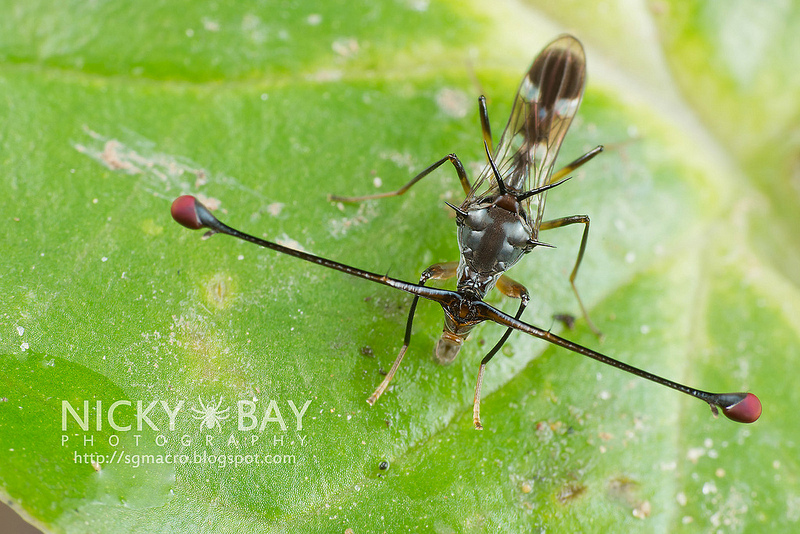 |
| Figure 16: A species of Stalk-eyed flies photographed in Dairy Farm. Courtesy of Nicky Bay. |
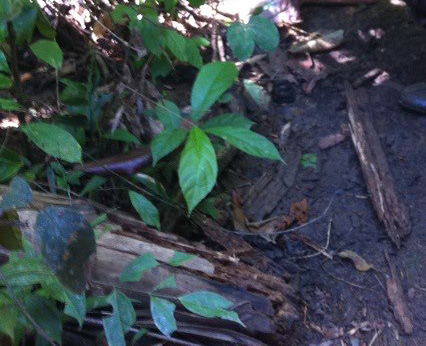 |
| Figure 17: Example of habitat where Stalk-eyed flies could be found |
View Distribution of Stalk-eyed flies in Singapore in a larger map
Map 1: The location of Stalk-eyed flies photographed in Singapore.
Global distribution
Most of the described Stalk-eyed flies species are found in the Old World with the Afrotropical region having the most species. There is only two species found in the New World and are found in temperate North America. The distribution of Teleopsis dalmanni and other Teleopsis species are restricted to South East Asia [24] . Teleopsis dalmanni have a wide distribution in
this geographical range. They were collected from Indonesia, Thailand, Malaysia, Borneo, and Phillipines. This species was first discovered by Wiedmann in Jakarta (type locality) in 1830.
Biology
[23]Diet
Adult Teleopsis dalmanni diet consists of yeast, mold and fungi found on rotting vegetative matter. Larvae of this species are saprophagous and feed on decaying matter.
Daily activity pattern
Teleopsis dalmanni diet consists of yeast, mold and fungi found on rotting vegetative matter during the day. Field observation reveals that this species normally act aggressively towards conspecific of both sexes during the day. From dusk to dawn, the flies will form aggregations on threadlike plant structures, for example, exposed root hairs, where males will compete to displace each other from the aggregation, and copulation occur (See mating system). In the field, marked flies were often observed on the same threads, an indication of place memory and place constancy[3]
Life cycle
Stalk-eye flies shared the same general life history pattern (Figure 18), although fecundity, age of sexual maturity and longevity varies among species.
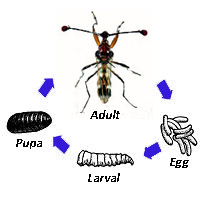 |
| Figure 18: General life cycle of a Stalk-eyed fly |
Life span of adults
In laboratories, adult Teleopsis dalmanni can live for an average of 4 months and easily reach over 6 months. This long life span is not only observed in the laboratory: the age of field-caught Teleopsis dalmanni were estimated from pteridine eye pigments to be, on average, over 30 days, with large adults surviving over 200 days.
Sex ration of adults
Sex ratio of adult Teleopsis dalmanni are found to be female biased with a ratio of 1.187: 1[3]. This ratio is found in both lab culture and wild population.
Culturing Teleopsis dalmanni
[25] Teleopsis dalmanni can be easily cultured using cages or containers with strings suspended from the roofs to mimic root hairs, and lined with moistened kitchen towel to provide moisture. Corn puree can be provided as egg-laying substrate and food for both adult and larvae. Corn puree can be prepared by grinding the whole ears (without removing the husk) and appropriate amount of water in a food processor to make a pulp. Mold-inhibitor solution and fungicide can be added in small amount to prevent mold and fungal growth.High mating frequency in Teleopsis dalmanni: Why?
The sperms of a male Teleopsis dalmanni are transfer to females in a goud-shaped spermatophore (sperm package). The spermatophore of a T. dalmanni is relatively smaller to those of other diopsids (5% of Teleopsis quadriguttata[26] ), and only occupies only a part of the vaginal cavity. This is because as the mating system of Teleopsis dalmanni provides males in a harem with multiple mating opportunities, hence males do not have to invest on a large spermatophore per copulation. As a result, the number of sperm transferred to females to be very low [27] . It was found that only about 55% of eggs laid by females in the wild were fertilization [9], and fertility of females declined when there is no access to mate. These indicate that females faced sperm shortage. The problem of sperm shortage is further elevated by the presence of X-linked meiotic drive element in males T. dalmanni which reduces the fertilizing ability of affected males[28] . Therefore, it is beneficial for females to mate multiple times in order alleviate the problem of sperm shortage, and to increase the number of fertile eggs.On the other hand, high mating rate is beneficial for the males too as it increases the number of eggs it can inseminate, and to gain an upper hand in sperm competition as females mate multiply and there is high incidence of sperm mixing in T. dalmanni [29] .
Limiting factors for mating frequency
In insects, males’ accessory glands secrete products that mix with the sperms and form the casing of the spermatophore which will be transfer to females during copulation. There is a significant decrease in accessory gland length of Teleopsis dalmanni after mating[30] . Hence, males need to ‘rest’ for 8 to 48 hours for their accessory gland to recover slowly. Furthermore, male mating frequency is also constrains by how rapid sperm and seminal fluid is replenish.
(Back to top)
Intrasexual competition in Teleopsis dalmanni
Figure 19: Two males Teleopsis dalmanni fighting. [Image embedded from Flickr, permission pending from Dr. Samuel Cotton]
Males compete for ownership of a female aggregation. The winner of the combat will be in control of the aggregation sites, increasing its reproductive success.Table 2 describe aggressive behaviors of different intensity displayed by males during an encounter, and Figure 20 describe the sequence of events during a contest between males.
What does it takes to win?
The length of eye stalk strongly affects the outcome of the males’ competition over a female aggregation. Males with larger eyespan, independent of body size, are more aggressive and win proportionately more aggressive interaction than males with smaller eye span[6]
.
Males engage in aggressive interaction not only for control over site (mating opportunity) but also for food resource. It was found that during competition for food resource and territories, eye span is positively correlated with outcome of the competition and fight duration decreases as difference in males’ eye span increased [31] . Aggressive interaction between males shows pattern of escalation with no de-escalation, and often involve physical contact but no injuries.
Do females fight too?
Females do fight for resources too. However, unlike the males, eye span was found not to affect the outcome of intrasexual competition between females Teleopsis dalmanni. Rather, it is body size that determines the outcome of a competition; with larger females more likely to win an encounter[32] .
| Behavior |
Description |
| Low-intensity behaviors |
|
| Approach opponent |
Movement toward opponent |
| Line up eye stalks |
Oriented with eye stalks to opponent’s in parallel function |
| Rear up |
Use mid-and hind-legs to rise in posture |
| Flex and extend forelegs |
Bends and flicks forelegs near own eye stalks; directed at opponent |
| High-intensity behaviors |
|
| Jump attack |
Jumps on opponent’s dorsal side |
| Attack/lunge |
Use forelegs in downward motion, striking at or on opponent |
| Tussle |
Entangled with opponent, either clasping opponent’s forelegs or eye stalks |
| Conflict Resolution behaviors |
|
| Away |
Turning away or slowly moving away from opponent |
| Pursue |
Quickly moving after opponent while no longer facing opponent |
| Retreat |
Quickly moving from opponent while no longer facing opponent |
| End |
Eye stalks are no longer aligned for a minimum of 3 s or flies are at least one body length apart |
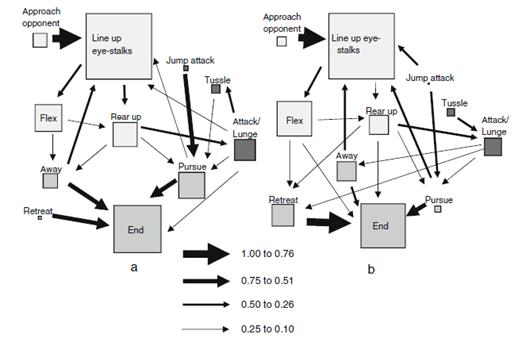 |
| Figure 20: Kinematic diagram of trial winner (a) and loser (b) behavioral transitions that occurred more frequently than expected by chance in contests of male T. dalmanni. Box size indicates frequency of behavior; arrow thickness indicates probability. Light shading is indicative of low-intensity behaviors, dark shading indicates highintensity behaviors, and medium shading indicates end-of-contest behaviors. Extracted from [Extracted from Figure 2; Egge, Brandt & Swallow, 2011] |
Diopsinae
Diopsinae is a taxonomic group of fly in which members posse the eye stalks. This group is nested within the Diopsidae, the Stalk-eyed flies. However, taxonomists do not agree with what constitute the Diopsidae. The traditional definition of Diopsidae includes the Centrioncinae, in which members do not have the eye stalks, and the Diopsinae. However, some taxonomists argue that the Centrioncinae should not be included in the Diopsidae, and should treat as a different group.[20] Stalk-eyed flies in this page refers to the members of Diopsidae that includes Centrioncinae.
References
Hurley I, Pomiankowski A, Fowler K, Smith H., 2002. Fate map of the eye antennal imaginal disc in the stalk-eyed fly Cyrtodiopsis dalmanni. Development genes and evolution. 212:38- 42.
Burkhardt D.and Motte I, 1983. How Stalk-Eyed Flies Eye Stalk-Eyed Flies: Observations and Measurements of the Eyes of Cyrtodiopsis whitei(Diopsidae, Diptera). Journal of comparative physiology.151:407-421.
Kotrba M., 2004. Baltic amber fossils reveal early evolution of sexual dimorphism in stalk-eyed flies (Diptera: Diopsidae). Organisms, Diversity & Evolution. 4:265–275.
Small J., Cotton S., Fowler K., Pomiankowski, A., 2009. Male eyespan and resource ownership affect contest outcome in the stalk-eyed fly, Teleopsis dalmanni. Animal Behaviour. 78:1213–1220. 6
Cotton S., Fowler K., Pomiankowski A., 2004. Condition dependence of sexual ornament size and variation in the Stalk-eyed fly Cyrtodiopsis dalmanni. Evolution. 58(5):1038-1046.
Baker R.H., Ashwell R.I.S., Richards T.A., Fowler K., Chapman T., Pomiankowski A., 2001. Effects of multiple mating and male eye span on female reproductive output in the stalk-eyed fly, Cyrtodiopsis dalmanni. Behavioral Ecology. 6: 732-739.
Wilkinson G.S., 1993. Artificial selection alters allometry in the stalk-eyed fly Cyrtodiopsis dalmanni (Diptera: Diopsidae). Genetical Research. 62:213-222.
Husak J.F., Ribak G., Wilkinson G.S., Swallow J.G., 2011. Compensation for exaggerated eye stalks in stalk-eyed flies (Diopsidae). Functional Ecology. 25: 608–616.
Rogers D.W., Grant C.A., Chapman T., Pomiankowski A., Fowler K., 2006. The influence of male and female eyespan on fertility in the stalk-eyed fly, Cyrtodiopsis dalmanni. Animal Behavior. 72: 1363-1369.
Reguera P., and Pomiankowski, A., 2004. Low cost of reproduction in female stalk-eyed flies, Cyrtodiopsis dalmanni. Journal of Insect Physiology. 50: 103-108.
Burkhardt D., and Motte I., 1985. Selective pressure, variability and sexual dimorphism in stalk-eyed flies (Diopsidae). Naturwissenschaften. 72: 204-206.
Földvári M., Pomiankowski A., Cotton S., Carr M., 2007. A morphological and molecular description of a new Teleopsis species (Diptera: Diopsidae) from Thailand.Zootaxa. 1620: 37-51.
Meier R., and Hilger S., 2000. On the egg morphology and phylogenetic relationships of Diopsidae (Diptera: Schizophora). Journal of Zoological Systematics and Evolutionary Research//.38: 1-36.
Shilliito J.F., 1940. Studies on Diopsidae (Diptera). Novitates Zoologicae. 42: 147-163.
Transaction of the Linnean Society of London. 1837. Vol. 17, pp. 309.
Meier R., Baker R., 2002. A cladistic analysis of Diopsidae (Diptera) based on morphological and DNA sequence data. Insect Systematic & Evolution. 33 (3): 325-336.
Wilkinson G.S., and Dodson G.N., 1997. Function and evolution of antlers and eye stalks in flies. In: The evolution of mating systems in insects and arachnids. Eds: Choe J. and Crespi B. pp. 310-328. Cambridge University Press, Cambridge.
Lorch P., Wilkinson G.S., Reilo PR., 1993. Copulation duration and sperm precedence in Malaysian stalk-eyed fly, Cyrtodiopsis whitei (Diptera: Diopsidae). Behavioural Ecology and Sociobiology. 32: 303-311.
Kotrba M., 1996. Sperm transfer by spermatophore in Diptera: new results from the Diopsidae. Zoological Journal of the Linnean Society. 117:305–323.
Corley L.S., Cotton S., McConnell E., Chapman T., Fowler K., Pomiankowski A., 2006. Highly variable sperm precedence in the stalk-eyed fly, Teleopsis dalmanni. BMC Evolutionary Biology.6:53.
Rogers D.W., Chapman T., Fowler K., Pomiankowski A., 2005. Mating-induced reduction in accessory reproductive organ size in the stalk-eyed fly Cyrtodiopsis dalmanni. BMC Evolutionary Biology.5:37.
Panhuis T.M., Wilkinson G.S., 1999. Exaggerated male eye span influences contest outcome in stalk-eyed flies (Diopsidae).Behavioral Ecology and Sociobiology. 46: 221-227.
Al-khairulla H., Warburton D., Knell R.J., 2003. Do the eye stalks of female Diopsid Flies have a function in intrasexual aggressive encounters?Journal of Insect Behavior. 16(5).


